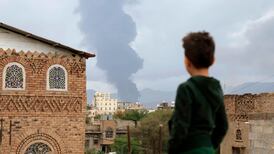Palmyra is a city of ghosts. Ghosts of a precarious present as well as an illustrious ancient past. The new city has been emptied of its 750,000 citizens as well as 250,000 refugees settled here to escape Islamic State fighters who occupied Deir al-Zor to the north.
But there was no escape. Islamic State came, saw and conquered. The new city is a ghost town, its blasted, burnt and bludgeoned buildings sheltering the Syrian soldiers who, with Russian air cover and Hizbullah muscle, drove Isis gunmen north with 2,500 families – some Isis members related to fighters, others hostages and slaves.
The ancient Graeco-Roman trading city hosts the ghosts of many conquerors but none so determined to lay waste to monuments that had stood the test of time until May 2015. The square defined by the mauled municipality on one side and the battered museum on the other was the site of atrocities against monument and man.
0 of 5
One of the first victims was the Lion of Lat, a first century BC statue of a lion gripping a crouching gazelle, now a flattened jumble of stones. The museum building, hurriedly cleared of all but its largest and heaviest treasures two days before Isis arrived, has been holed by mortars. The floor is littered with fallen wood, plaster and stones, and statues in graceful flowing robes have been beheaded.
On the steps of the museum, Mohamed al-Asaad, who has worked here for 26 years, says “we are trying to close the holes in the roof and craters in the floor made by shells, and repair the building”.
Isis captured Mohamed’s 82-year-old archaeologist father, Khaled al-Asaad, Palmyra’s guardian angel, in a nearby village where he had been hiding, tortured him and decapitated him in this dusty square, hung his body on a short metal structure on a traffic circle and put his head between his feet, with his glasses poised on his nose.
Russian soldiers
Beyond this killing ground is a post commanded by a Russian army captain, smart in full uniform, flanked by armed and tanned young soldiers with bare torsos. The officer forbids photos of Russians but tells us we can walk safely through the shining limestone ruins, the entrance guarded by a pair of Russian soldiers in black, automatic weapons by their sides.
A photographic drone is initially banned by the captain but soon it is soaring, circling and buzzing like a hive of angry bees over the sentinel columns basking in the hot spring sun. The 2,000-year-old Bel Shamim Temple was the first one that Isis exploded. The ground has been cleared of rubble and only empty arches remain.
The Victory Arch consists of two stumps and a huge pile of rubble. The amphitheatre which used to host concerts and plays remains intact. Here a victorious Islamic State lined up 25 Syrian soldiers on the stage and ordered teenage recruits to execute them.
Graffiti on the gate to the compound housing the Bel Temple, dating to 32 AD, warns “citizens and brothers [Isis members] that entry is forbidden”. The monument, rival to Lebanon’s Baalbek, has been reduced to a single arch sitting on top of a mound of whole and broken limestone blocks, some of them massive, bleached white over the centuries.
The wind picks up as we walk along the colonnade of the Straight Street, the main thoroughfare of Graeco-Roman Palmyra. Joseph, a tour guide who now guides journalists, points to the small shelves high up on the columns. “There were statues of generals on these shelves. They were put so high so they could be seen by Zenobia [3rd century AD] and her retinue as they rode by on their camels.”
Echo of explosions
Palmyra glows golden as the sun begins to sink in the late afternoon. The voices of the department of antiquities team sent to survey the damage to the site echo among Palmyra’s 1,300 columns. The flat, metallic report of near and far explosions roll over the vast site as out-of-sight Russian sappers blow up mines, sending up smoke signals that are frittered away by the breeze.
I stroll out of the ruins with Wael al-Hafian, chief engineer of the Homs branch of the antiquities department. “It will take a month to clear the mines before we can begin the technical work [on the broken monuments] . . . Palmyra was ruled for 1,400 years by Muslims who did not seek to destroy it. Only these [Puritan] Wahhabis have tried. They want to take away our history, culture and identity so that we will accept them.”
We drive up a sandy, lumpy road to the citadel looming dark brown over the ruins. A tanned soldier with a moustache reaches out and shakes my hand as if to congratulate me for expelling Islamic State from Palmyra.















